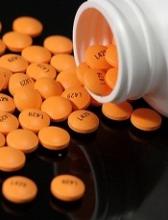WASHINGTON, DC—Results of a phase 2 trial suggest rivaroxaban and aspirin have similar safety profiles in patients with acute coronary syndrome (ACS) who are also taking a P2Y12 inhibitor.
Researchers found that, overall, the risk of bleeding was similar whether patients received aspirin or rivaroxaban.
There was no significant difference between the groups when the researchers used TIMI, GUSTO, or BARC bleeding definitions.
However, patients who received rivaroxaban did have a significantly increased risk of bleeding according to the ISTH major bleeding definition.
There was no significant difference between the treatment groups when it came to the study’s efficacy endpoints, although the researchers said the study was not adequately powered to assess efficacy.
These results were presented at the American College of Cardiology’s 66th Annual Scientific Session and published simultaneously in The Lancet.
The study, known as GEMINI-ACS-1, was funded by Janssen Research & Development and Bayer AG.
In this trial, researchers compared rivaroxaban (given at 2.5 mg twice daily) and aspirin (at 100 mg once daily) in patients with ACS who were also receiving clopidogrel or ticagrelor for the secondary prevention of cardiovascular events.
The trial included 3037 adults with unstable angina, non-ST segment elevation myocardial infarction, or ST segment elevation myocardial infarction. Patients had positive cardiac biomarkers and either ischemic electrocardiographic changes or an atherosclerotic culprit lesion identified during angiography.
Within 10 days of hospital admission for ACS, the patients were randomized to receive aspirin (n=1518) or rivaroxaban (n=1519). Patients also received clopidogrel (n=1333) or ticagrelor (n=1704) based on investigator preference.
Patients received a minimum of 180 days of study treatment. The median treatment duration was 291 days.
Safety
The study’s primary endpoint was TIMI clinically significant bleeding not related to coronary artery bypass grafting (CABG) up to day 390.
This type of bleeding occurred in 5.3% of patients in the rivaroxaban group and 4.9% of patients in the aspirin group. The hazard ratio (HR) was 1.09 (P=0.5840).
The researchers also assessed other types of bleeding and used other bleeding definitions. The HRs for these endpoints (with aspirin as the reference) were as follows.
- TIMI major bleeding, HR=1.25 (P=0.6341)
- TIMI non-CABG major bleeding, HR=1.25 (P=0.6341)
- TIMI minor bleeding, HR=2.25 (P=0.1664)
- TIMI bleeding requiring medical attention, HR=1.01 (P=0.9581)
- TIMI insignificant bleeding, HR=0.84 (P=0.5504)
- GUSTO life-threatening or severe bleeding, HR=1.50 (P=0.6571)
- GUSTO life-threatening, severe, or moderate bleeding, HR=1.58 (P=0.3395)
- GUSTO life-threatening, severe, moderate, or mild bleeding, HR=1.04 (P=0.7869)
- BARC 3a and higher bleeding, HR=1.70 (P=0.1263)
- BARC 3b and higher bleeding, HR=1.38 (P=0.4882)
- ISTH major bleeding, HR=1.83 (P=0.0420)
Efficacy
Researchers also examined several exploratory efficacy endpoints. For the composite efficacy endpoint (which included cardiovascular death, myocardial infarction, stroke, and stent thrombosis), the 2 treatment groups had similar rates.
Five percent of patients in the rivaroxaban group and 4.7% of patients in the aspirin group experienced one of these cardiovascular events. The HR was 1.06 (P=0.7316).
There was no significant difference between the treatment arms for the individual components of the efficacy endpoint or for all-cause death.
The HRs were 1.12 (P=0.7401) for cardiovascular death, 1.15 (P=0.4872) for myocardial infarction, 0.58 (P=0.2506) for stroke, 1.37 (P=0.4917) for definite stent thrombosis, and 0.95 (P=0.8771) for all-cause death.


